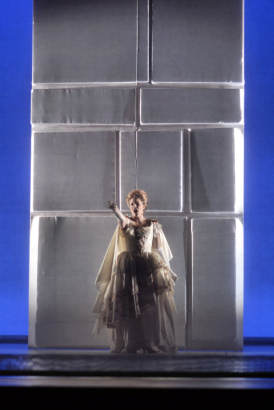Marin
Marais, Sémélé: (New
Production) Soloists of L'Opéra National de Montpellier,
Chorus and Orchestra of Le Concert Spirituel, Hervé Niquet
(conductor), Montpellier, France. 30.01.2007 (MM)

Marin
Marais (1656-1728) though familiar perhaps to a
few cello cognoscenti for his massive collection of cello
solos and duets, was most likely unknown until now to
the opera public. Well, the opera public of Montpellier
that is, one that often finds itself in coping with very
rare repertory.
Cellist and pedagogue Marin Marais wrote four operas of
which Sémélé was apparently the second. Though
the work was not a success when performed in 1709, the
Centre de Musique Baroque de Versailles nonetheless has
resurrected it or at least a portion of it. This
version was first given last summer in a concert performance
at the Radio France Montpellier Festival, and this past
week (January 30, February 1, 3) the Opéra National de
Montpellier added costumes, sets and movement for the
principals.
As seen in Montpellier, Sémélé, is a slight work
and just how much of it we actually saw is,
in fact, a lingering question. The performance
lasted a mere two and one half hours, though a Lully tragedie
lyrique (the last was Armide, 1686) and a Rameau
tragedy (the first was Hippolite et Aricie, 1733)
rarely come in under four hours, sub-plots, choruses,
ballets and orchestral interludes included.
The story line in Montpellier was made tight, too tight,
involving only seven characters, Jupiter and jealous Juno,
Sémélé and her earthly fiance Adraste, Sémélé's maid Dorine
and her lover Arbate, actually Mercure in disguise, and
Sémélé's father Cadmus. No longer displaying the
great emotions of Lully's chivalric heroes, this Sémélé
anticipates the small intrigues and jealousies of Rameau's
pastoral setting.
There were a several
important chorus scenes, though Marin Marais' original score will have had many
more. There was no ballet though there was certainly ballet music, truncated to
be sure thus saving the problem of providing choreography and dancers. Chorus
and ballet are the heart and soul of French Baroque opera, and they were sorely
missed in Montpellier.
The visual ideal of the production was realized by the exquisite costumes of
Giusi Giustino, a mix of detailed period and abstracted modern dress. It was
immediately apparent that that this production was about design, not
about theater.
Director Olivier Simmonet in his debut as a metteur
en scène provided an obvious, soap opera staging,
ending the opera with the spurned, silent Juno alone on
stage, a prosaic comment on Sémélé's triumphal ascension
into the heavens. His production included spectacular
video intrusions realized by Calicot Productions that
gave us changing locales and huge close-ups (many all
too close) of the singers, depriving the stage of depth
by creating a two-dimensional canvas like a flat television
screen.
Gilles Cenazandotti's scenery consisted of abstracted architectural shapes
carved in white foam and white painted ropes construed in tree and swing shapes,
these in relief against a large square of changing saturated color, again
negating all sense of depth. The overall effect was at worst like department
store window dressing and at best handsome.
The glory of French Baroque opera is its dramatic recitatives,
and these were delivered by a largely non-French cast.
The beautiful Shannon Mercer regally intoned the gloriously
ornamented speeches of Sémélé and Anders J. Dahlin not
only cut a fine figure as Adraste but also sang this haute-contre
role elegantly (no castrati here!). The Dorine of Bénédicte
Tauran (from Limoges) was quite charming against the rough
voiced Mercure of bass Lisandro Abadie while the
Jupiter of Thomas Dolié and the Juno of Hjordis Théault,
fine performances as well, had the misfortune of
being the subjects of most of the close-ups. These
are singers, not TV actors after all.
Montpellier hosts a fine Baroque music group, Le Concert
Spirituel, with an excellent conductor, Hervé Niquet.
This large ensemble is able to accomplish the difficult
French court and Accademie works with utter finesse.
Lacking the splendour of French Baroque opera's spectacle
on the stage, this performance made up for it from
the pit, with impressive thunder provided by the old
trick of simply shaking and striking a sheet of zinc,
and with an earthquake, its terrifying effects made by
three bassoons underscoring the basses through the length
of this extended scene. More impressive yet was
the chorus of Le Concert Spiritual, joined in the pomp
and terror scenes by the brilliant tones of the high Baroque
trumpet. This chorus, in abstracted stage movements,
was twenty fine, discernibly individual voices joined,
not melded into a mighty sound when needed, and diminished
to individual whispers when appropriate.
Over the past few years the Montpellier Radio France Festival and the Opera
National de Montpellier, under the same artistic direction, have turned out
excellent productions of rare Italian Baroque operas (granted production
requirements are much less stressful than for multi-form French Baroque opera).
Exploring the rare French repertory is a most exciting project, particularly
with the excellent musical resources available to Montpellier. Unfortunately
this Sémélé and last year's Calliroé have not attained the
production standard Montpellier has set for itself.
Michael Milenski
Picture
© Marc Ginot, Opéra National de Montpellier
Michael Milenski's web site is Here



